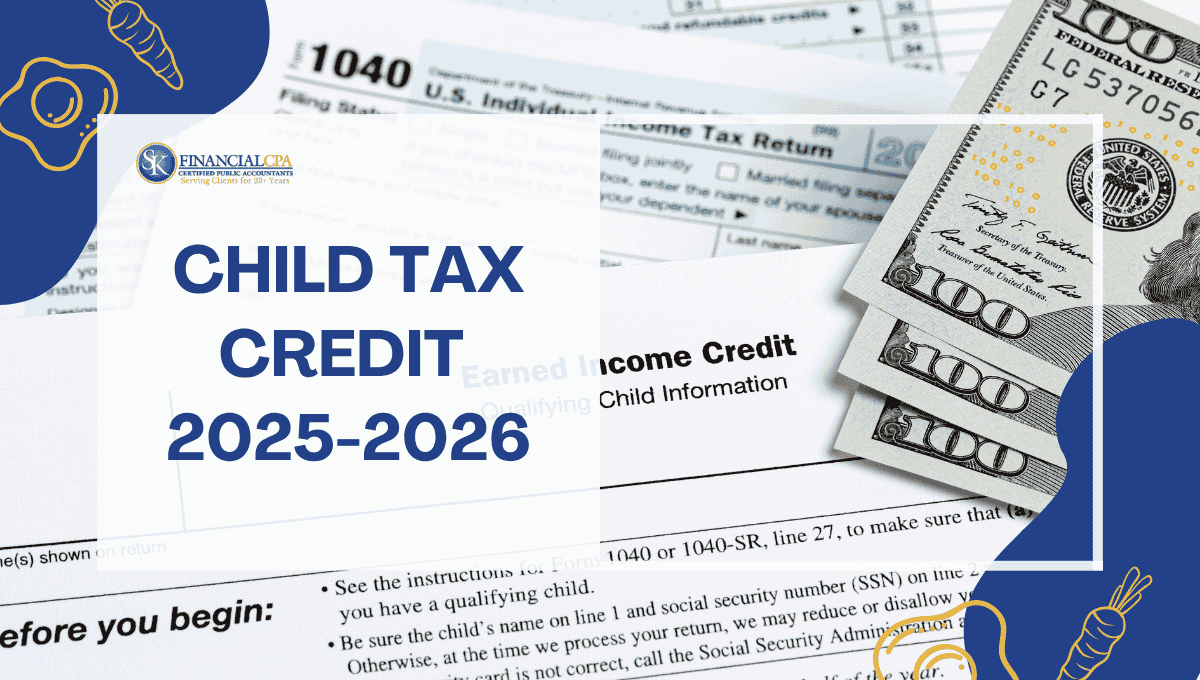
Child Tax Credit 2025-2026: Eligible Criteria and Expect Tax Refund
The Child Tax Credit helps with the high cost of raising kids. Families can get up to $2,000 for each child under 17 in 2026. If your credit is higher than your tax bill, you may be able to get back up to $1,700. In this guide, we'll talk about who can get it, how much you can get, and the changes that will happen in 2026.
Know about: Retirement Savings Contribution Credit
What is Child Tax Credit?
The Child Tax Credit 2026 is a key source of support for many American families. It shows that the government is dedicated to helping families take care of their children. This tax credit is meant to help families with the costs of raising children by giving them a large tax break.
Explore about: Earned Income Tax Credit EITC
What is the Child Tax Credit for 2026?
The Child Tax Credit is a federal tax benefit that reduces the amount of income tax you owe if you have dependent children. For 2026, each qualifying child is worth up to $2,000. Out of this, $1,700 can be refundable through the Additional Child Tax Credit (ACTC).
Example: If John and Maria have two children ages 8 and 12, they could qualify for up to $4,000 in tax credits. If their tax bill is only $2,800, the remaining $1,200 may be refunded.
Check more about: Lifetime Learning Credit (LLC)
Eligibility Rules for 2026
To claim the Child Tax Credit in 2026, your child must meet these requirements:
-
Age: Under 17 at the end of the year
-
Relationship: Your son, daughter, stepchild, foster child, sibling, or a descendant (like grandchild)
-
Residency: Lived with you for more than half the year
-
Support: Did not provide more than half of their own support
- Income Limits: Credit phases out above $200,000 (single) or $400,000 (married filing jointly)
Example: A single parent earning $65,000 with one 10-year-old child qualifies for the full $2,000 credit.
|
Rule |
Requirement |
|
Age |
Under 17 by Dec 31, 2026 |
|
Max Credit |
$2,000 per child |
|
Refundable Amount |
Up to $1,700 |
|
Income Phase-out |
$200,000 (single), $400,000 (married) |
How Much is the Child Tax Credit in 2026?
In 2026, families can get up to $2,000 per qualifying child. If your credit is larger than your tax bill, you may still get a refund of up to $1,700 per child.
Example:
-
A family with three kids under 17 could get $6,000 total.
-
If their tax bill is $4,000, they would still get $2,000 refunded.
Changes to the Child Tax Credit in 2026
What’s new for 2026?
-
Refundable portion rises slightly: Up to $1,700 compared to $1,600 in earlier years
-
Phase-out thresholds unchanged: Still $200,000 single / $400,000 married filing jointly
-
Advance monthly payments remain paused: Unlike 2021’s pandemic rules, no monthly checks are planned for 2026
These changes mean most families will see benefits similar to 2025, with small increases in the refundable portion.
How Income Affects the Credit
|
Adjusted Gross Income (AGI) |
Impact on CTC |
|
Up to $200,000 (Single) / $400,000 (Joint) |
Full $2,000 per child |
|
$200,001–$240,000 (Single) / $400,001–$440,000 (Joint) |
Partial CTC (reduced) |
|
Above $240,000 (Single) / $440,000 (Joint) |
Minimal to none |
Example: James and Lisa earn $420,000 jointly with two kids. Their credit is reduced from $4,000 to about $2,000 because of the phase-out.
Impact of the Child Tax Credit on Families
The Child Tax Credit helps many families pay for things like groceries, rent, or school supplies. In a survey from 2025, parents said they used their tax refunds to pay for childcare (34%), school (27%), and bills (39%).
For example, A Texas single mom with two kids used her $3,400 credit to pay her rent and buy school supplies. This is the real effect this credit has on people's daily lives.
How to Claim the Child Tax Credit in 2026
To get the Child Tax Credit in 2026
-
Send in your Form 1040 tax return
-
Fill out Schedule 8812 (Credits for Qualifying Children and Other Dependents).
-
Give your child's Social Security number.
-
Check the limits and phase-outs for income again.
Tip: File a return even if you don't usually have to pay taxes to get the money back.
Child Tax Credit For 2025
-
The credit remains at $2,000 per qualifying child under the age of 17. This means if you have three qualifying children, you could potentially reduce your tax liability by $6,000.
-
Up to $1,700 of the credit is refundable, which is crucial for families who owe little or no federal income tax. In this case, you could still receive a refund check from the IRS, providing additional financial support for your family.
-
For Single Filers If you earn over $200,000, the credit amount starts to decrease. For every $1,000 over this threshold, your credit is reduced by $50. For Married Filing Jointly the phase-out begins at $400,000, which means many middle-income families will still be eligible for the full credit.
Example: Consider a married couple earning $450,000 annually with two children. Since their income exceeds the $400,000 threshold, they will lose $50 of the credit for every $1,000 above $400,000. In their case, the reduction will total $2,500, leaving them with a significantly lower benefit.
Conclusion
Families can still save a lot of money on their taxes with the Child Tax Credit 2026. With up to $2,000 per child and $1,700 that can be refunded, it gives parents more time to pay bills, send their kids to school, and cover other costs. The most important thing is to know if you qualify and to file your taxes correctly so you don't miss out.
FAQs
How much is the Child Tax Credit in 2026?
Up to $2,000 per child under 17, with $1,700 refundable.
Can grandparents claim the CTC?
Yes, if the child lived with them more than half the year and they provided over half the support.
What if parents share custody?
Usually, the parent with the child more than half the year claims it. In equal custody, parents must agree who claims.
Do I need to file a return?
Yes. Even low-income families must file to get the credit.
What If My Child Turns 17 During 2025?
If your child turns 17 in 2025, they will no longer qualify for the Child Tax Credit. However, you may still be eligible for other credits, such as the Earned Income Tax Credit (EITC) or the Credit for Other Dependents, which offers up to $500 per qualifying dependent.
Follow SKFinancial on Facebook / Twitter / Linkedin / Youtube for updates.












